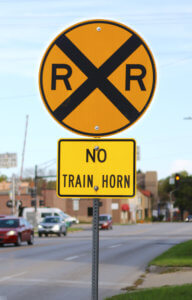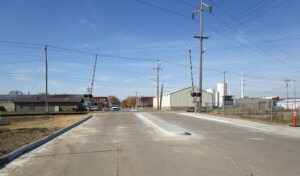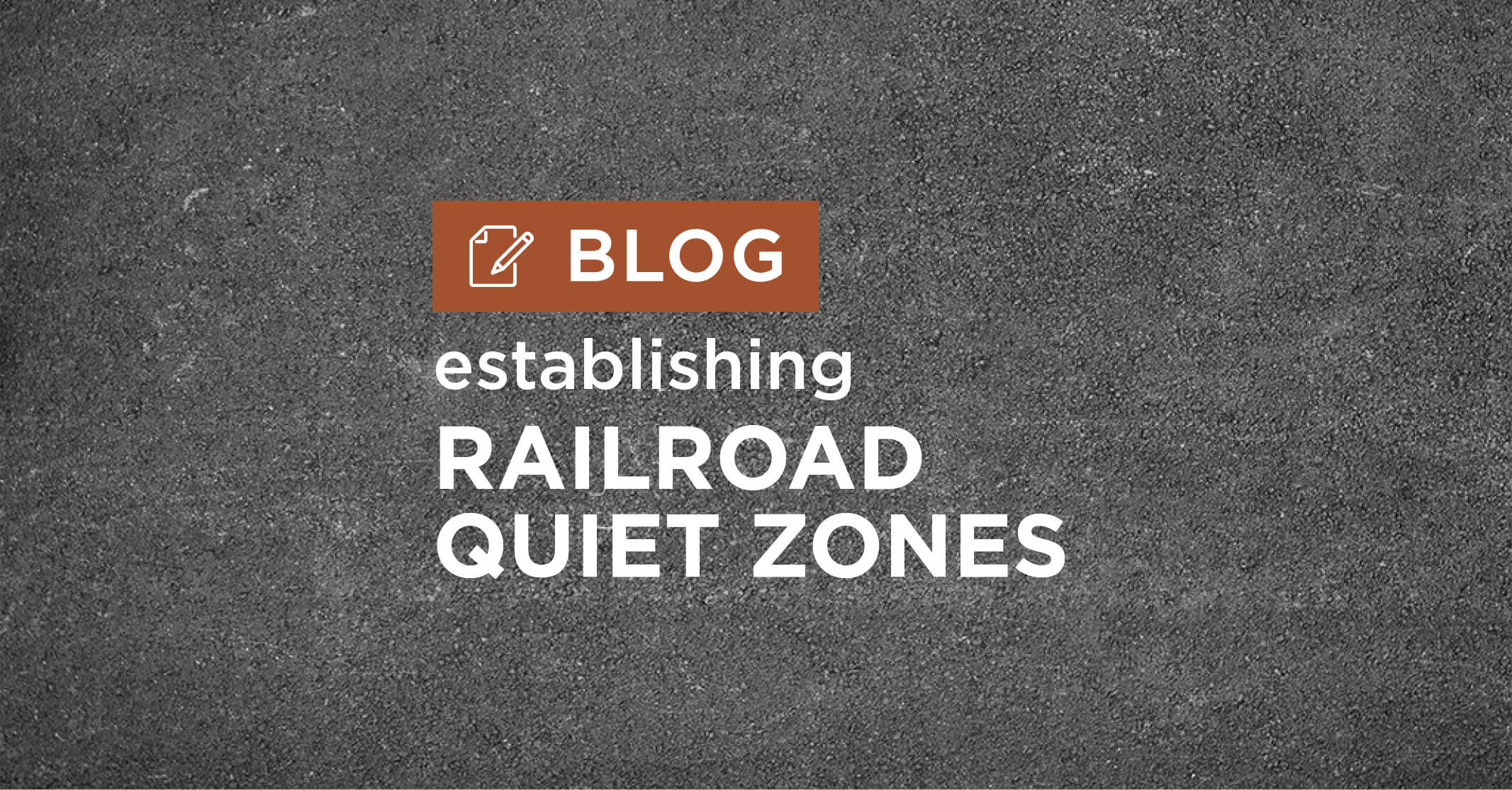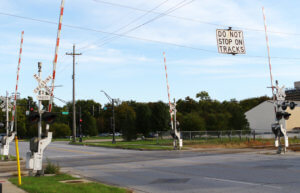Communities Coexisting with Train Traffic in America
In many communities throughout America, trains passing through (often at high speeds) are viewed as a way of life — a cost of small-town living. Many residents have become accustomed to avoiding crossings whenever possible to prevent getting stuck waiting for a long freight train moving through town.
As train horns grew louder over several decades, many communities instituted “whistle bans” to quiet the horns during certain hours of the day. Due to these whistle bans, however, accidents at grade crossings increased, leading Congress to demand the Federal Railroad Administration (FRA) institute a national regulation on the sounding of train horns.
FRA’s Rule on the “Use of Locomotive Horns at Public Highway-Rail Grade Crossings”
In response to the order from Congress, the FRA created a policy that required trains to blow their horn at a volume between 96 and 110 decibels using a standardized pattern and duration. The policy also stated that under normal circumstances, train engineers must start blowing their horns at least 15 seconds before all public grade crossings. The horn must be sounded in a specific pattern until the lead locomotive occupies the crossing. In some communities with multiple, closely-spaced crossings, that would mean the horn would be sounding almost constantly until the train cleared the last crossing.
Recognizing that many communities with whistle-bans in effect would be upset with the new policy, the FRA also paved the way for creating “Quiet Zones” that followed a set of standardized rules. The rules aimed to provide communities a way to silence the train horns but also maintain a level of safety that compensates for the risk that silencing train horns at grade crossings creates.
What Comprises a “Quiet Zone”?

Warning signs are required at quiet zone crossings to alert drivers that train horns will not be sounded.
Essentially, a Quiet Zone can be created through an exemption to the new FRA rule. These zones comprise crossings where improvements have been made that allow the train to proceed without using the horn (except in the case of emergencies). The rules for establishing a Quiet Zone are extensive, and implementing them can get expensive. Snyder & Associates has helped many communities find the right solutions for establishing their Quiet Zones in the most cost-effective way. The minimum standards to be considered for receiving a Quiet Zone designation include:
- Each crossing within the desired Quiet Zone must have gates, flashing lights and bells, constant warning time devices, and power-out indicators.
- The Quiet Zone can include one crossing or multiple crossings but must be at least ½ mile long.
- Warning signs of the crossing alert drivers that they’re entering a quiet zone.
Qualifications to Become a Quiet Zone
To determine if a crossing or a series of crossings is eligible to become a Quiet Zone, the FRA developed an online calculator that can be used to assign a Risk Index score to each crossing. The calculator helps determine whether a crossing meets the criteria before funds are allocated for proposed improvements. The Quiet Zone Risk Index score from the calculator is compared to numerous risk thresholds. If the Quiet Zone Risk Index score is below the thresholds, the proposed crossing(s) is eligible. Snyder & Associates has substantial experience guiding communities through this critical early assessment stage.
Top 4 Most Common Supplemental Safety Measure (SSM)
If not already present, communities typically need to implement Supplemental Safety Measures (SSMs) to provide maximum safety of the crossings in question. The addition of supplemental safety measures varies significantly in cost. The four most common improvements include:
- Closing Crossings. If feasible, permanently closing one or more crossings greatly reduces the safety risk in a rail corridor. The railroad’s first choice of improvement is closure. Closing a crossing is generally the least expensive option, as well. (Temporary closures may be used if the Quiet Zone is only in effect during designated periods.)
- Four-Quadrant Gates. Four-quadrant gates provide a gate for entering and exiting traffic on each side of the roadway at a crossing. The extra gates for the exiting vehicles prevent motorists from driving around a standard two-quadrant gate system. Four-quadrant gates are typically one of the most expensive SSMs.
- Two-Quadrant Gates with a Median or Channelizing Device. Using a raised median or other channelizing devices (extending 60′ minimum distance from the gate arms) on the crossing street helps to eliminate the possibility of motorists driving around the gates.
- Convert Roadway to One-Way Traffic. Gates across the entire roadway are still required on the approach side of the crossing.
Since many crossings already utilize two-quadrant gates, adding medians or channelizing devices is often considered a medium-cost compromise between closing a crossing and adding four-quadrant gates. Snyder & Associates can evaluate each desired Quiet Zone area to make the best recommendation.
Use of Alternative Safety Measures (ASM) in Quiet Zones
In some unique situations that prevent SSMs from fully complying with the requirements, other Alternative Safety Measures (ASM) may be considered in consultation with the FRA and the railroad with jurisdiction over the crossing. These ASMs fall into two categories — engineering and non-engineering ASMs. Engineering ASMs would include roadway design changes, such as crossing and roadway geometry improvements and sight distance upgrades. Examples of non-engineering ASMs encompass programmed enforcement measures by law enforcement, public education and awareness initiatives, and photo enforcement at select crossings.
Funding for Quiet Zone Improvements
As mentioned earlier, upgrading one or more crossings to meet Quiet Zone requirements can be expensive — commonly averaging more than $250,000 per crossing when upgrading to four-quadrant gates. Additional improvements needed on the road, such as adding a median, can further increase the cost.
There are some limited funding options available through individual railroads. Still, they’re usually reserved for high-speed, high-risk crossings or locations where a crossing closure may be a component of the overall improvements. Since the railroad companies don’t view the typical Quiet Zone as a safety measure, they rarely participate in the cost of the improvements, instead leaving these expenses to individual communities.
For this reason, many municipalities find it more prudent to implement Quiet Zone measures in conjunction with a road reconstruction project around the crossing, where money is already being allocated toward improvements. This allows modifications to be made in smaller stages instead of tackling multiple crossing upgrades simultaneously. Snyder & Associates can help structure improvements to best meet your community’s unique situation and help locate available funding options.
Communities We’ve Helped Achieve Quiet Zone Status

Clinton, Iowa, received updates, including a new concrete median leading up to the railroad crossing.
Snyder & Associates has performed numerous Quiet Zone studies for cities and towns, like Clinton, Iowa, and St. Joseph, Missouri, exploring the possibility of making the necessary improvements to achieve Quiet Zone status. We’ve also designed large-scale projects that were but a smaller piece toward the ultimate goal of implementing a Quiet Zone, like Jefferson, Iowa. Citizens in communities that have established Quiet Zones speak about its transformational effects on their quality of life. Without the constant blare of train horns interrupting outdoor (and sometimes indoor) activities, the positive impact on people’s lives is immeasurable.
Is a Quiet Zone Right for Your Community?
Many cities have reduced the noise pollution from train horns in their communities by establishing a Quiet Zone. The first critical step in the process is examining the proposed Quiet Zone location and determining what’s needed. This process is straightforward but can involve discussions with the railroad and government agencies. Partnering with an experienced firm like Snyder & Associates can help streamline the process, verify that all improvement options are explored, and ensure that funding opportunities aren’t left on the table.

